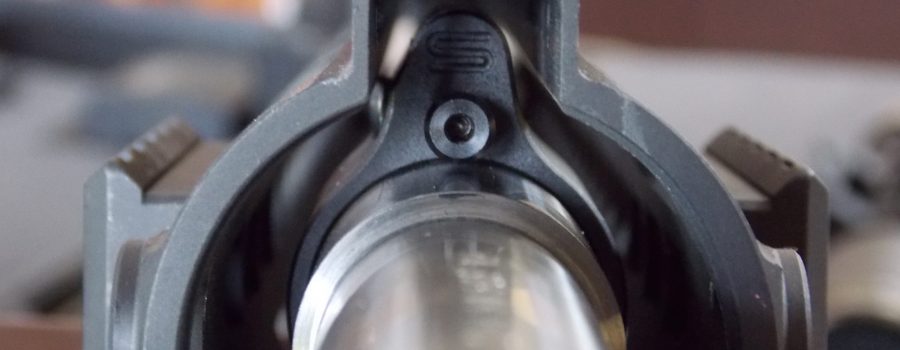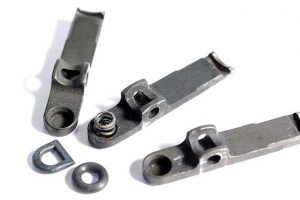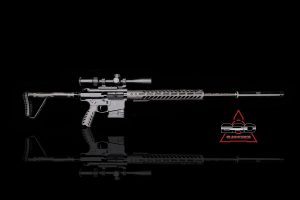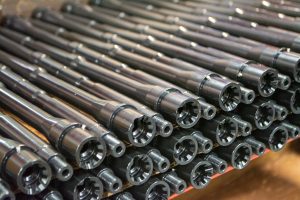I think my disdain of adjustable gas blocks is well known. I’ve written about it a lot in various media posts as well as vocalizing my disparagement and providing data and experiences to back it all up. Do I think that an adjustable gas block has a place in the AR platform? Yes, a very specific one, but the majority of end users and keyboard commandos do not fall within this specific niche. Adjustable gas blocks do not belong on defensive or duty weapons. Otherwise, adjustable gas blocks are a band-aid that treat the symptoms and not the root cause of too much gas.
I’m going to get this out of the way right now. Adjustable gas blocks DO NOT increase gas to the BCG. They can only restrict the gas. Are we clear on this? Good to go? Got it? Good. If you need more gas to make your AR operate, then you have bigger problems than that of an adjustable gas block.
So why use an adjustable gas block? In a nutshell, excessive pressure is getting into the gas system too quickly causing all aspects of ill idiosyncrasies.
These include:
- Excessively quick bolt unlocking
- Excessively high bolt carrier velocity (back and forth)
- Excessive hammering of action parts and internal parts of the lower receiver
The “shorter” the guns get, the more these issues arise, and also the greater their effects are.
- Rifle-length barrel and gas port location: not much really to worry about
- Carbine-length: more to worry about
- Pistol-length: much to worry about
The reason is that there’s a lot more gas port pressure nearer the chamber than there is farther down the barrel. Combine this with shorter dwell times and larger gas port sizing, and there is a lot of pressure being dumped into the AR gas system.

For a reference relating to the 5.56 NATO:
- Rifle-length gas systems are typically found on 18”+ barrels and has the gas port located approximately 12” ahead of the receiver face.
- Intermediate gas length systems can be found in barrels from 12.5” to 16” long, and have the gas port located 9” in front of the receiver face.
- The carbine length gas system typically found in barrel lengths from approximately 10.3” to 16” and has the gas port at 7” in front of the receiver face.
- The pistol length gas system may be as short as a 7.5” barrel (or even less) with a gas port a scant four 4” ahead of the receiver face.
Other calibers such as the 300 BLK may have barrel lengths and gas systems that differ from the above mentioned. An example of this is the 300 BLK 10.3” barrels that have pistol length gas systems. This is due to the design of the cartridge and its operational characteristics as it relates to internal ballistics. You will also find that gas port sizes of the 300 BLK and other calibers are not comparable or relative to the 5.56 NATO.
An example. I recently had a 300 BLK in for service. It was a 10.5” 4150 CMV barrel with a pistol length gas system. Upon measuring the gas port diameter I found it to be .103”. You will not find a pistol length gas system on a 10.5″ 5.56 NATO barrel. Now it’s not apples to apples, but I had a recent 8.5” 5.56 NATO barrel with pistol gas and the gas port measured .063”. That’s quite a difference.
“ADJUSTABLE” GAS BLOCKS
Check out the majority of FB Groups, forums, or your local gun shop and I will guarantee that you will hear the rampant running myth that the best way to fix an excessively gassed AR-15 is to “just slap an adjustable gas block on there” and live happily forever.
Yeah….. not so much. Actually….. not at all.
As I stated in the beginning, there are a couple of very specific circumstances where they can be useful and effective devices. But they are not on defensive or duty guns! The only two classification of guns that I would consider using an adjustable gas block on are competition guns and possibly a hunting gun.
An adjustable gas block is best described as a “valved” gas block. The function they provide comes in one of two essential ways. They either restrict gas, or they vent gas.

Those that restrict provide a means to effectively alter the gas port opening size, kind of like opening or closing a water faucet. Those that vent provide an outlet, a bypass, for excessive gas to exit without entering the DI gas system. This is usually out the front of the block itself.

Both of these are user-adjustable and also require consistent maintenance. Like after each visit to the range. I don’t know that there’s a clearly superior approach, as it is about half of one and half of another.
WHEN TO USE ONE
If you don’t want to fix the root cause of the gas condition, then an adjustable gas block may be for you. What does fixing the root cause entail? A properly built AR. Or replacing the barrel with one that is properly ported to work with the dwell time that it has. With suppressors almost becoming the norm now, a lot of barrel manufacturers have begun to port their barrels on the conservative side to work with or without a suppressor attached. Some even market suppressor specific barrels in where the gun will not operate properly unless a suppressor is attached. But let’s set all of this aside. All of this while related to the topic, is a whole other conversation.
In my experience I think an adjustable gas block may be a perfect or required component on a competition rifle. Whether this is 3-Gun, PRS, 2-Gun, or something similar. In most of these games, seconds count. That means that quick splits count, a flat shooting rifle is preferred, etc. In PRS a flat shooting rifle is also quite an aid. It is one of a few things that will aid you in seeing your splash and calling your shots. I’ve seen a number of PRS competitors that run suppressors. This increases gas pressures which can increase recoil and felt recoil. An adjustable gas block in this case may be beneficial. While most serious competitors handload and can tune their ammunition to their rifle (pretty much negating the need for an adjustable gas block), other competitors do not. Those individuals may benefit from an adjustable gas block. Or, maybe you’re running a competition rifle that is using an ultra lightweight BCG, a variant of a SCS buffer system, tuned power factor loads, and you want to be able to adjust the amount of gas to your rifle set-up for that lower felt recoil and less movement of the optic. Then an adjustable gas block would serve you well.

If you have a pure range toy that is not properly gassed, then an adjustable gas block may be an option. AR’s used for hunting may also be a candidate for an adjustable gas block. This is where I personally fall. I run an adjustable gas block on my .450 Bushmaster that is used for deer hunting. As yes it has failed. It failed in less than 100 rounds. But, some calibers and circumstances may prove beneficial in a hunting gun. I run an adjustable gas block because at times I do load ammunition that is on the “hot” side of load data, but still within load specifications and safe in my gun. This is a whole other conversation too. But, the adjustability allows me to restrict some gas to the gas system which results in “softer” felt recoil while still retaining the advantages of the hotter load. I’ve tested this through chronograph testing with the same load but the gas block in different positions of restriction. Maybe you have a junior shooter or a shooter that has a medical condition like shoulder concerns. Being able to reduce the gas on that hunting gun may be an option and also prove to be beneficial.

My current preference for an adjustable gas block is the SLR line. Currently it is considered to be one of the best. But they too are prone to failure. Especially their first generation ones that had leaf spring concerns. The gas block that failed on my 450 Bushmaster was an SLR. In less than 100 rounds the spring seized and wouldn’t keep tension on the adjustment screw. This allowed the screw to adjust itself under recoil. Sometimes it would open up and provide more gas while at other times it would reduce gas and induce cycling concerns.
WORDS OF CAUTION
If you are going to run an adjustable gas block, I do not advise to run adjustable gas systems on a 5.56 NATO pistol-length gun! It will not work well and it will not work long. For the same reasons, I would also avoid running it on a carbine gas length system. There’s such a huge dose of hot gas hitting the block interior that it’s not going to hang out over the long haul. With the already-abbreviated volume available within the system, there’s less room for error in a short system. Longer gas systems are more flexible.
A point that gets missed is that the adjustable gas block becomes a part of the gas system, and it’s the same gas system that was overactive. That gas was overactive because it contained too much high-pressure, and really hot gas.
The main cause of the excessive gas effect is the gas port location being closer to the chamber. That’s where the adjustable gas block will also go. Again, we are not addressing the root cause of the over gas concern, but just applying a band-aid with an adjustable gas block.
Adjustable gas blocks require consistent maintenance. They won’t last forever and they will fail at some point. Usually sooner than later. The adjustment that was once carefully put on it will not last either. The internals of the adjustable gas blocks (mainly the adjustment screw) will corrode and erode from the heat and flame front.
Look in the barrel of a well-worn AR-15 and you’ll see an eroded area just beyond (toward the muzzle) the gas port. That’s from flame-cutting, the same culprit as what causes chamber throat erosion. Now compare that to the tiny adjustment screw within the block. The trick is that, after time, the adjustable gas block may not remain adjustable.
Both the erosion and the carbon deposits that get into the valving effectively alter the pressure, getting into and then through the system. This is one area of some difference in the restricting or venting designs, but the result is that function will change. This will require occasional adjustment of the adjusting screw to keep your gas settings where you want it. That is until the adjustment screw or the spring (if it uses one) seizes.
Preventive maintenance can help to keep the adjustment screw from seizing, but it’s not a given. After each range trip you should apply some oil (I prefer Kroil) to the adjustment screw and run it in and out a few times, and then return it to its setting. And there’s a chance nothing can be done about that. I’ve seen them lock and no longer adjust. As previously stated, this is typically due to carbon on the adjustment screw, or I’ve seen some that have a leaf spring for tension also seize up. When an adjustable gas block seizes up, it effectively becomes a fixed gas block. And as the adjustment screw erodes, it will continue to provide more and more gas to the system.
A tip on getting the best performance over the longest life with an adjustable block:
- Don’t get too greedy on restricting gas flow into the system. Get function to 100 percent and then open it up at least a little bit more. I go at least 2 clicks more. This is very important for a gun that may be used in different temperatures, humidity, elevation, and with different brands of ammo.
ALTERNATIVES FOR ADJUSTABLE GAS SYSTEMS
Fix the gun, or if you’re assembling from new, select a barrel with a longer gas system length and the correct porting that will operate with your accessories and buffer system. Don’t want to do that? Then there are a couple of band-aids that can be applied. They won’t fix the concern but they will help to tame some of the gas.
First up, and my preferred fix for an over gassed gun that utilizes a low profile gas block, is to install a metered orifice gas tube. But they are not made for every gas length on the market, so one may not be available for your AR. These are made by Black River Tactical. There are calculations that need to be made such as the current gas port size, buffer spring rate and buffer weight, current ejection pattern, is it suppressed, and other things. Based off all of this a calculation will be done that will provide a port size. Order the correct gas length gas tube with that port size and and install it in your AR.

Don’t like that idea? Then you can ramp up buffer weight and also the buffer spring rate. What this does is delay the bolt unlocking to give a little more time for chamber pressures to drop. This has some negative effects too though. Here’s a few.
- Can make the charging handle noticeably harder to pull due to the spring rate
- Dependent upon the selected spring rate and buffer weight, you may induce short stroking or other operational concerns
- Can increase felt recoil due to increased moving mass and the stronger spring rate moving the BCG forward
- Can induce more sight, dot, or reticle movement during the operation of cycle
One thing to keep in mind is that these band-aids treat the symptoms, and not the root cause.
HOW TO SET AN ADJUSTABLE BLOCK
First off, follow the manufacturer’s directions. But here is a procedure that I have found to work on every gas block that I have encountered, and I’ve found that it provides for reliable operation.
If you are using multiple brands of ammunition, bullet weights, anything that affects velocity, then you will want to do this procedure with the “hottest” ammo you are going to use. Not sure which one that is? Then set your gas block to one type and then repeat the procedure with the other types of ammunition that you will be using. Make sure that each type operates properly. You may find that you need to adjust the block to another type of ammunition.
I start by closing it down all the way. Load only one round at a time (an empty magazine is in the gun, round chambered). Shoot and test. Open the adjustment screw until the bolt locks back on an empty magazine.
Then test it with a few magazine-fed rounds. If it is operating correctly and locking back on an empty magazine 100% of the time, open the gas block up two more clicks or about another fourth of a turn.
FINISHING THOUGHTS
Do not treat the symptoms, threat the root cause. If you are assembling an AR then choose a properly gassed barrel that meets your requirements. Are you running a suppressor or most likely will? How often? If it is going to be suppressed 100% of the time then shop around for a barrel that is manufactured and ported specifically for suppressor use. Are you going to run a suppressor some of the time? Most barrel manufacturers offer a barrel that has a conservative gas port size that will work with or without a suppressor.
If you already have a gun that is over gassed and maybe even causing feeding concerns because of it, then I would highly recommend installing a gas tube from Black River Tactical if they have one that you require. I’ve installed a number of these, all with success, and they last. Prior to installing one in any client gun I installed one in a test gun and ran the heck out of it. No concerns. As of right now, all of the ones that I’ve installed still have happy clients using them.
You can try to increase lock time by increasing the buffer spring rate and buffer weight. In my experience if you have a gun that is consistently ejecting to approximately 2:30 to 3 o’clock, then you may be able to get decent results without excessive spring rate or buffer weight. If you are ejecting between 12 o’clock and 2:30 then you need to consider the other options.
If you have a competition gun or a hunting gun that you want to reduce the operational gasses on, then I would consider this a valid candidate for an adjustable gas block.
Just remember, if you decide to go the route of an adjustable gas block that you will need to provide maintenance to it as provided above. Also remember that adjustable gas blocks will require adjustment as they wear. And most likely at some point, they will fail.
I’m not against adjustable gas blocks for select purposes, but what I am against is using them in applications such as on defensive or duty rifles. And it is these applications that I see and get the most inquiries about. A defensive or duty rifle is a life saving device that has to work. Therefore it should be built as such.
So is an adjustable gas block an option? Yes. But, there are better options out there.
BRD Gun Works~ Performance you can afford when can’t afford failure



